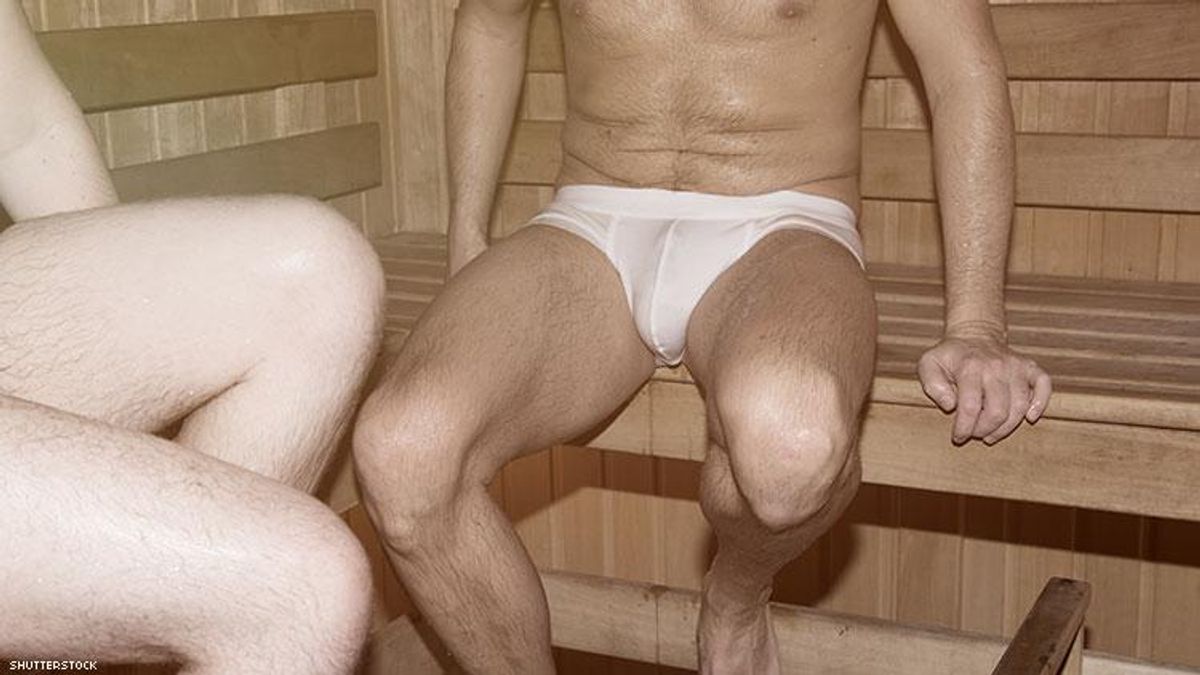All Rights reserved
By continuing to use our site, you agree to our Private Policy and Terms of Use.
When I first came out, the man I was dating took me to a popular cruising area in the city.
Cruising, for those unfamiliar, is a term primarily used for those who visit public locations (often parks and forests) in pursuit of sex. He wanted to show me what it was like being a gay man pre-Grindr and I appreciated the lesson.
However, the moment we stepped out of the vehicle, my arms instantly crossed.
"You're not comfortable here at all, are you?" he asked with a smirk, revelling in my innocence. The idea of hooking up outdoors in secret with complete strangers seemed wildly irresponsible and dangerous. Then again, I was newly out and had no idea what it was like being queer, much less at a time when identifying as such was far less accepted.
Fast forward a year and a half, and I was frequenting my first bathhouse in Montreal.
I was visiting and a friendly couple at a bar asked if I'd like to join them and their friends for some drinks, as they'd seen I was alone. After chatting with them for a few hours, we established a friendly repertoire. Soon after, they asked me to join them at the bathhouse across the street. I decided to go, mentioning that I'd never been and was reluctant. They reassured me there was nothing to worry about.
Trending stories
Turns out, they were right. The experience was better than I could have ever anticipated. It was scary - perhaps overwhelming is the better word - I'll admit.
The lights were dim, the men were naked (save for the few who wrapped towels around their waists), and the only thing on television was hardcore gay porn. The place was reminiscent of a nightclub, except lockers replace coat check and sex dungeons replace dancefloors. Showers were scattered about and people had sex in rentable rooms in maze-like corridors (or did it publicly).
But for a Saturday night, the place certainly wasn't full.
As a writer concerned with paying my own rent in an overpopulated and expensive city, I wondered how such a large building could afford to remain in business. I then wondered whether the convenience of Grindr, the app that essentially revolutionized gay sex for men (and what I'd been using while on vacation), had any impact on this industry, and, in some way, is the reason the bathhouse - and many others - often appear so empty. Bathhouses are certainly suffering: nearly 200 bathhouses operated inside the United States in the '70s, according to USA Today.
The number has since narrowed down to about 70.
I brought my Grindr theory to Doug, the man who approached me at the bar in Montreal. He admitted that he still frequents a bathhouse once a month on average, but will go more often when he's out of town, having visited bathhouses in Toronto, Montreal, San Francisco, and Los Angeles. And he told me he doesn't consider apps like Grindr and Scruff mutually exclusive.
"I've definitely met Grindr and Scruff hookups at bathhouses, especially if neither of us could host," he shares. "I also meet regular fuckbuds at bathhouses, often for the same reason."
Doug also cites ease of location, the diverse selection of men (who aren't on the apps), making friends while travelling ("I've definitely met some long-standing friends at bathhouses") and "messy" acts like fisting for visiting a bathhouse.
"I also often go with my husband and our boyfriend. It's a fun way to do something sexual together without having to arrange for additional sexual partners, and it allows each of us to do our own thing while also having fun in the same space," he adds.
Bathhouses are essenitally playgrounds for gay men, he argues.
"People enjoy bathhouses because it's easier to get a feel for someone in person. People flake online too much," Matt, an employee at a popular bathhouse in Toronto, shares. "Bathhouses (can) have bars which makes it more social. The facilities (hot tub, sauna, etc.) are convenient, sexy and, let's be real, it's nice to get immediate gratification."
Matt contends apps, while convenient, have their drawbacks, citing flakes, bots, ads, catfish and the nature of an app's "notably cold and distant" interaction as reasons patrons visit a bathhouse. "We have many regulars whom I imagine like the non-sexual times as much as the sexual times."
"For me, it's the hedonistic environment. I am a total sub bottom, so walking around nude with other men leering at me is hot," Trenton, a regular at bathhouses, shares. "I also love the noises and sounds of sex. It's an animalistic place. I am bi, so it's so fun to indulge my love of sex with men in a place specifically designed for that."
Trenton grew up in conservative Texas and bathhouses in San Antonio, Austin, and Dallas were the places he explored and experienced his sexual awakening, safe from violence and judgement. "It's where I figured out what I wanted," he says. "They are just special to me."
I brought up stigmas that bathhouses face like being alleged drug-fueled havens to Matt, and asked if he'd like to dispel any of them or if they don't apply to the apps.
"I can't say bathhouses aren't drug-filled because some bathhouses are less strict than mine," Matt shared. "I can't say they aren't dirty because bathhouses around the world operate under different standards."
However, Grindr is not really any different.
While the app insists it prohibits the promotion of drug use in its user profiles and is committed to creating a safe environment, a 2017 study in Thailand concluded that gay dating apps "significantly increased motivational substance use through messaging from their counterparts."
The report says persuasion through dating significantly influenced people toward accepting a substance invitation, with a 77 percent invitation success rate. And while research on meth and Grindr in particular is limited, other studies suggest a similar influence.
But something that is noticeably different between Grindr and bathhouses is the age of patrons or users, however that is beginning to change.
Previous generations have been comfortable with the cruising nature of a bathhouse due to culture they were exposed to, whereas younger generations were stereotyped as being more comfortable sending a naked photos before texting "hello."
"Bathhouses do tend to have an older clientele on average, in comparison to say a hookup app, but I think that we're seeing a resurgence of people attending events at bathhouses," says Jason Orne, assistant professor at Drexel University and author of Boystown: Sex and Community in Chicago.
Ornes says that a growing group of younger patrons are beginning to attend bathhouses, especially on theme nights.
"The rise of kink culture, the increasing acceptance (or return of acceptance) of casual sex and multiple partners, and reduction (in some communities) of HIV stigma due to the U=U campaign and PrEP, I think has led to an increase in bathhouse attendance among young people."
As a result, Orne believes bathhouses are a great representation of the current divide in gay communities.
"Between gay men that are looking to assimilate into straight culture ('I'm with a man, but there's no other difference between me and straight people.') and queer men that embracing their sexuality and are experiencing a resurgence in sexual spaces and communities."
While bathhouses have undoubtedly suffered throughout the years, it's unclear whether this is due to the cultural shift that sex apps have perpetuated. More likely, it's the result of multiple factors (a privatization of sexuality driven by hookup apps, a rejection of men-only environments that exclude women and transgender people, pressures on sexually explicit businesses from regulations and gentrification).
Gay bars have suffered a similar fate, as LGBTQ acceptence has made exclusively queer spaces less of a requirement, which is not exclusively Grindr's fault.
But whatever the reason, bathhouses, while not as popular as in their heyday, are here to stay - even if not as present as before.
Over the weekend, I published a poll on Twitter, asking my followers if they think bathhouses will remain in business in 10 to 20 years. Despite the indisputable trend that more and more bathhouses are closing with every year, the results were resoundingly in favor that yes, bathhouses will certainly remain in business.
"I do think they may have to change up their business model to become more like community hubs and multipurpose spaces. Ironically, much like the bathhouses that we saw in New York in the 1970s," Dave, one of the men who voted in the poll, shares. "The warehouse parties that we are seeing now are one extension of those sexual spaces."
While the way gay men socialize and pursue sex has undoubtedly shifted, but it's evident we're still deeply nostalgic for the social nature of a bathhouse.
And with sex-positive parties gain serious momentum in metropolitan cities as gay bars continuing to disappear, it should be noted that these new spaces are the very reflection of what the bathhouse has done seemingly forever.
Because they both are places where people can socialize away from their phone, and are one of the only places where we can still connect by disconnecting.
And this fact is something an app cannot and will not ever possess.
BOBBY BOX is a prolific freelance writer and editor in Toronto. His work on sex, sexuality, and culture has been published in The Daily Beast, Playboy, Billboard, AskMen, Complex, and NewNowNext. Follow him on Twitter @bobbyboxington.



















































































